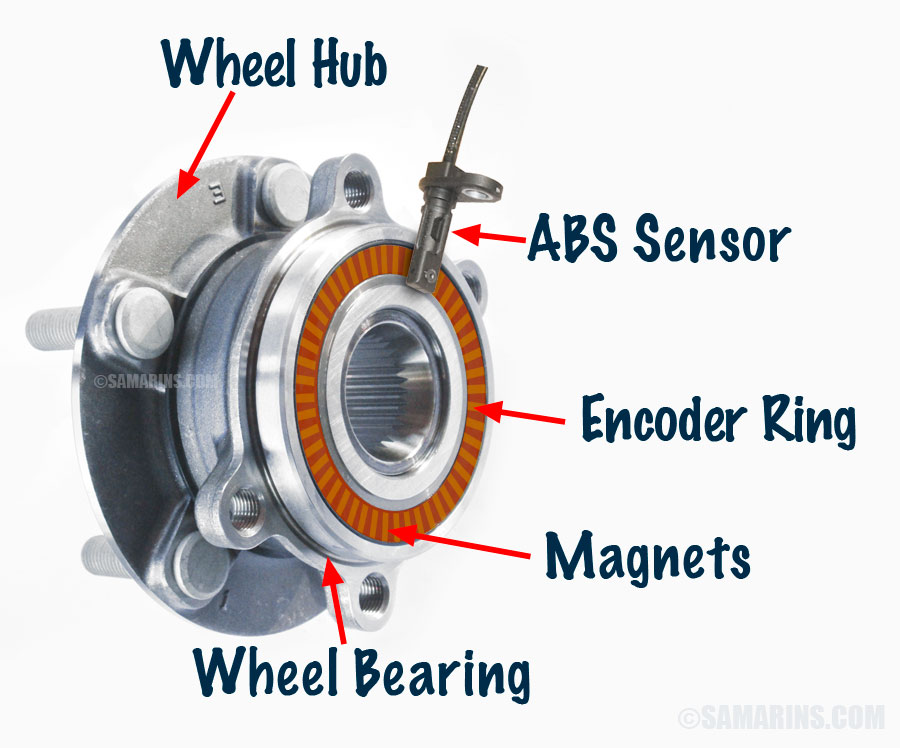A car typically has four-wheel speed sensors. These sensors are crucial for the vehicle’s braking system.
Wheel speed sensors monitor each wheel’s speed, sending data to the car’s electronic control unit (ECU). This information helps manage the anti-lock braking system (ABS) and traction control. Understanding how many wheel speed sensors a car has is essential for maintaining these systems.
In this blog post, we’ll explore the role of wheel speed sensors, their importance, and how they contribute to your car’s safety. Stay with us to learn more about these small yet vital components.
Basic Concept Of Wheel Speed Sensors
Wheel speed sensors are small devices in cars. They help the car know how fast each wheel turns. This is important for safety systems. They help with ABS (Anti-lock Braking System) and traction control. Each wheel usually has one sensor. So, a car with four wheels has four sensors.
There are two main types of wheel speed sensors. Passive sensors are simpler and cheaper. They do not need an external power source. Active sensors are more advanced. They need power to work. Active sensors give more accurate data. They are used in newer cars.
Number Of Wheel Speed Sensors In A Car
Most cars have four wheel speed sensors. Each sensor is placed on a wheel. These sensors help in measuring the speed of each wheel. The data is sent to the car’s computer.
Some cars may have different configurations. High-end cars might use more advanced sensors. Older models might have fewer sensors. Trucks and larger vehicles can have extra sensors. Always check your vehicle manual for exact details.
Front Vs. Rear Wheel Speed Sensors
Front wheel speed sensors are usually placed near the front wheels. They are often located on the hub or axle. Rear wheel speed sensors are placed near the rear wheels. Their location is similar to the front sensors.
Front sensors help with steering. They provide data for ABS and traction control. Rear sensors are key for stability. They send signals to the car’s computer. Both types help in safe driving. Each has a unique role.

Credit: www.autotechiq.com
Impact On Vehicle Systems
Wheel speed sensors are crucial for the ABS system. They help prevent the wheels from locking up. This improves braking efficiency. Traction control also relies on these sensors. They help maintain grip on slippery surfaces. Without them, cars could skid more easily.
Stability control systems use wheel speed sensors too. They help keep the car stable during sharp turns. These sensors monitor each wheel’s speed. If a wheel is too fast or slow, the system adjusts. This keeps the car from spinning out of control.
Symptoms Of Faulty Wheel Speed Sensors
Faulty wheel speed sensors can show various signs. ABS light on the dashboard may turn on. Braking may feel less smooth. Traction control problems can also arise. The car might skid easily. Sometimes, the speedometer may stop working. These signs indicate sensor issues.
Faulty sensors can impact vehicle performance. The car may take longer to stop. Control becomes harder during turns. Traction on slippery roads may reduce. These issues can make driving unsafe. Fixing sensors is crucial for safety.
Diagnosing And Replacing Wheel Speed Sensors
Cars typically have four wheel speed sensors. These sensors detect the speed of each wheel for the ABS system. Replacing faulty sensors ensures safety and proper functioning of the vehicle.
Tools And Techniques
Use a scanner tool to check for error codes. A jack and jack stands help you lift the car. Wrenches are needed to remove the wheel. Screwdrivers can help to remove the sensor. Safety gloves protect your hands.
When To Seek Professional Help
If the ABS light stays on, consult a mechanic. Strange noises while driving also need attention. If you feel unsure, always ask for help. Professional mechanics have the right tools. They can fix the problem quickly.
Future Of Wheel Speed Sensors
New technologies make wheel speed sensors better. Smarter sensors give more accurate data. They help cars respond faster. Wireless sensors are also coming. They need less maintenance. These advances make driving safer.
Smaller sensors are easier to fit in cars. They do not take much space. This helps in designing better cars. Sensors are becoming more reliable. They work well in all weather. Better sensors mean fewer accidents.
Self-driving cars need good sensors. Wheel speed sensors help them understand the road. They send data to the car’s computer. The car then makes decisions. Accurate data is very important.
Sensors help in traffic management. They communicate with other vehicles. This helps in avoiding crashes. Sensors also help in parking. They guide the car into tight spots. Future cars will rely a lot on these sensors.

Credit: www.samarins.com
Credit: repairpal.com
Frequently Asked Questions
How Do I Know Which Speed Sensor Is Bad?
To identify a faulty speed sensor, check for error codes using an OBD-II scanner. Look for symptoms like erratic speedometer readings, transmission issues, or ABS warning lights. Test each sensor’s voltage with a multimeter to pinpoint the defective one.
How Many Wheel Speed Sensors Do You Have?
A car typically has four wheel speed sensors. Each sensor monitors the speed of one wheel. These sensors are crucial for ABS and traction control.
Do All Cars Have 4 Wheel Speed Sensors?
Not all cars have 4 wheel speed sensors. Most modern cars do, but some older or budget models may have fewer sensors.
Do All 4 Tires Have Speed Sensors?
Yes, all four tires typically have speed sensors. These sensors monitor each tire’s rotation speed, helping with ABS and traction control.
Conclusion
Understanding wheel speed sensors in cars is crucial. Most vehicles have four sensors. One sensor for each wheel ensures safety. They help with ABS and traction control. Regular checks keep them in good condition. Faulty sensors can cause problems. So, maintain them well.
Always consult your car’s manual for specifics. Stay safe and informed while driving.

